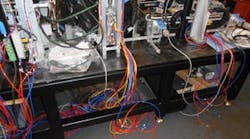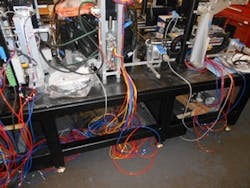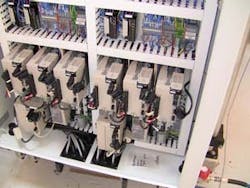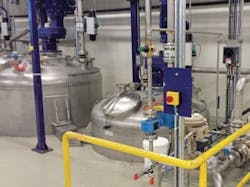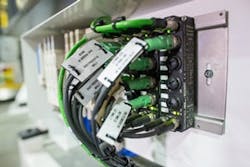Machine integration design decisions affect all parts of a machine, including power distribution, safety, I/O, system communication and the Industrial Internet of Things (IIoT). These integration decisions also affect the machine-build efforts and long-term maintenance of the machine or system. The labor for machine integration starts during mechanical build and continues through machine startup and operation. How can the latest automation technology simplify and speed machine integration for machine builders and system integrators?
Running discrete wires to all field devices has been a common integration method in the past, but there have been changes to machine integration methods over the years. Distributed I/O can move I/O, drives and even controllers out of the control enclosure onto the side of the machine at point of use. The IIoT is changing machine integration practices as well. There are many best practices to integrate machines to sensors, other machines and to the IIoT.
From many wires to a cable
Figure 1: While many end run wires and hoses are still connected to devices, distributed I/O is simplifying the installation.
(Source: Delta Technology)
Industrial machine integration methods have changed over the years. "Communication networks make connecting sensors and actuators much easier than the individual wiring used in the past, and the introduction of new industrial Ethernet protocols, such as EtherNet/IP, Profinet, EtherCAT, Powerlink and Sercos III, has improved communication capabilities tremendously," says Gary O'Dell, manager of applications engineering at Delta Technology, a system integrator in Phoenix. "There are still many wire and hose connections to be made during initial machine build and integration (Figure 1). These electrical and pneumatic connections will be around for a very long time, but from the distributed IO module to the sensor, IO-Link and similar networks are making the connections easier and adding smart sensor data to the machine."
Many years ago the standard method of communicating with the controller was a handful of discrete signals or proprietary communication protocols, says O'Dell. "Today, an entire machine's I/O, along with that I/O's status and diagnostic information, is transmitted on a single Ethernet cable to the controller instead of using dozens, if not hundreds, of wires and cables," he says.
Figure 2: Distributing I/O and servo drives to a remote cabinet and using the appropriate fieldbus network reduces startup and latency issues.
(Source: Matrix Packaging Machinery)
Industrial machine integration has evolved, says Rick Kirkpatrick, product manager, ac variable speed motors, at Baldor Electric. "The core concepts are the same," he says. "This includes reducing wiring costs, providing diagnostic machine information back to supervisory systems and providing a more reliable operating environment. What has changed is the actual communication networks used to convey the information and the integration of the Internet at appropriate locations."
Replacing wires with a cable is a common integration method. "When I started nine years ago, nearly all wiring in a tool or machine was point-to-point back to a central PLC," says Doug Putnam-Pite, director of software development at Owens Design, a system integrator in Fremont, California . "Now, any tool of significant size will use distributed I/O over a fieldbus. Distributed I/O on a fieldbus has reduced our wiring costs. Tool wiring runs are now shorter and less prone to errors, reducing machine startup times."
The move from discrete signaling and related wires to distributed, networked I/O has been noticeable to Mike Krummey, electrical engineering manager, Matrix Packaging Machinery in Saukville, Wisconsin. "This distributed I/O communication typically uses industrial Ethernet, and selecting the appropriate network for the specific need of the application is critical to reducing startup and latency issues," he explains (Figure 2).
Technology advances simplify things
"It wasn’t that long ago that engineers were designing systems on drafting tables and sourcing parts through the Thomas Register," states Dave Cameron, director of sales, electric drives & controls at Bosch Rexroth. "It’s amazing how far we’ve come in just the past 15 years. Today, if a system designer starts with a model-based system, he or she can perform complete, functional simulation in virtually every aspect before even building it. These new tools allow for optimization prior to putting the metal on the floor and saves engineering and commissioning time overall."
Machines are also much more modular than previous standalone machines, for a variety of reasons, continues Cameron. "Machine builders can offer a range of options instead of a one-size-fits-all design; plus the modularity allows them to take advantage of important new developments, such as cabinet-free technology to save space, minimize wiring and reduce energy use," he says.
Computer-aided design was still new 20 years ago, says Delta's O'Dell. "We were working in the 2D world of top, bottom and side view drawings during design and integration," he says. "Now, 3D modeling is a must for machine builders. It has made a faster design phase, a tighter machine integration and a more reliable final system. The ability to have low-cost computer stations on the assembly floor for the technicians to reference the solid model assembly directly minimizes the labor involved in machine build and integration. Additionally, automated systems in these same computers are used to track parts through the supply chain and flag problems immediately, reducing labor waste on the shop floor."
The move to distributed
"There are different philosophies of machine design in terms of distributed vs. central control,” says Bosch Rexroth's Cameron. "My perception from our customers is that more people designing industrial machines today tend to opt for the distributed mentality. As machines have become more complex and modular, a distributed control approach allows the machine builder to offer machine options or to be able to interface to other machinery. Distributed control enables this modularity and makes for easier integration of components."
Machine integration and automation should be planned in the conceptual phases of a machine project, says Baldor’s Kirkpatrick. "The amount of integration will usually have a considerable effect on the required wiring—control, power, communications—which must be accommodated in the design and installation phases," he says.
Many communication networks are now moving to Ethernet-based protocols—Profinet, Modbus/TCP, EtherNet/IP, EtherCAT—as opposed to the RS-485 serial communication networks that were initially used, says William Nyback, product marketing specialist, control panels, fieldbus, driveware, at ABB. "This brings the ability to connect easier as they are Ethernet-based and are much faster than the RS-485 interfaces used in the past," he explains. "It also brings the ability to have different network configurations—ring, star, daisy chain—and redundant networks such as device level ring (DLR) and media redundancy protocol (MRP) to ensure data is not lost if a device goes off the network by automatically redirecting the data around the ring."
Communication networks are extremely reliable, assuming the proper cabling is used for the network, continues Nyback. "Many diagnostics are also available from the network and the devices," he says. "These networks are done with much less cabling, reducing the possibility of wiring issues and large amounts of control wiring to manually wire into terminal blocks. It is much faster to troubleshoot devices with a communication network as there is a lot less wiring to sort through if something is not working."
ALSO READ: The popularity of integrated control and safety continues to improve
Sensor and actuator networks
"Automation technologies like IO-Link are leading to smart field devices that are essential to developing a smart machine," says Craig Brockman, business manager of sensing and connectivity, Rockwell Automation. "Field devices are getting smarter, and their integration into the overall automation system permits access down to the lowest field level. This allows the workforce to work smarter by having real-time information when and where they need it."
End users will be able to use this information to meet their productivity and efficiency goals, continues Brockman. "Smart devices provide transparency to the field level by providing advanced diagnostics that can reduce maintenance downtime and enable faster and more accurate troubleshooting," he says. "Additionally, advanced diagnostics can be used to support predictive and preventive maintenance."
OEMs that adopt smart devices will also see a reduction in their time to market. "These devices will now integrate faster into the overall machine architecture, reducing overall development time and providing OEMs a way to differentiate themselves from their competitors," says Brockman.
Figure 3: Using an unshielded two-wire AS-interface cable to connect actuators, sensors, rotary encoders, push buttons and valve position sensors greatly reduces the amount of field wiring needed.
(Source: Pepper+Fuchs)
Modern manufacturing facilities contain a large number of sensors and actuators for monitoring systems. "Such automation systems are typically controlled using PLCs, and, in most cases, the existing PLC is communicating on a higher-level bus," says Tom Corbett, product manager, factory automation photoelectric sensing, Pepper+Fuchs. "AS-Interface was designed for connecting conventional two-, three- or four-wire dc sensors and actuators in discrete manufacturing and process applications using a single two-conductor cable (Figure 3)." According to AS-International Association, more than 24 million AS-Interface field devices have been installed globally, growing at about 2 million per year.
"AS-Interface eliminates all the previous cable nightmares where each sensor and actuator had to be individually wired to the control," says Danius Silgalis, product manager, factory automation AS-Interface, Pepper+Fuchs. "AS-Interface modules can be directly wired to a standardized, unshielded two-wire AS-Interface cable. AS-Interface typically reduces wiring and installation costs by 40%. The single flat cable saves space in cabinets, conduit and cable trays by eliminating the complicated multitude of wires from discrete devices connected by conventional means. Savings in labor can be enormous because fewer wires to pull result in significantly reduced labor costs and result in simplicity, decreasing design time."
Choosing sensors and actuators with IO-Link can ensure your machine will be future-proof, says Corbett. "IO-Link technology serves as an interface, which allows the sensors and actuators themselves to communicate with different kinds of higher-level information systems," he says. "The sensors and actuators provide not only process data, but also valuable diagnostic and status information, which can be available internally or externally on the IT system. The ability of the sensors and actuators themselves to communicate is one of the requirements of the digital factory of the future."
Most controllers today utilize Ethernet for communication between machines, which is often built into the controller, says Doug Schuchart, regional manager, Beckhoff Automation. "As a result, machine builders and system integrators don’t have to put nearly as much effort and engineering into a design in order to ensure integrated connectivity," he says. "Further, industry standard protocols for machine-to-machine communication such as EtherCAT automation protocol (EAP) provide real-time communication over Ethernet along with simplified integration. Other standards such as OPC-UA provide encrypted communication between machines and the enterprise. Other IoT protocols exist, such as MQTT or AMQP, which represent major IT industry standards for simplified integration and connectivity. The machine builder or system integrator can ensure the ability to integrate with any upstream/downstream equipment and share data with the enterprise simply by selecting a controller that supports these open protocols."
Distributing power
Figure 4: Machine-mountable I/O boxes, such as this one located in an automotive manufacturing installation in Canada, can promote the idea of machinery without electrical cabinets.
(Source: Beckhoff Automation)
"Improved methods for distributing power across the machine facilitate the implementation of a single power drop or a reduced number of power drops," says Beckhoff's Schuchart. "In the past, multiple power drops were often required because there were no easy ways to distribute power and handle the associated voltage drop. Most control power today is low voltage, typically 24 Vdc, making power distribution much easier and safer. Power can now be channeled around the machine via cables of various gauges and IP67 power distribution blocks. EtherCAT P supports the use of one cable to carry the sensor and motor signals as well as the control power and high-voltage motor power for these devices. At Beckhoff, we refer to this as One Cable Automation. This reduces the need for electrical cabinets and power supplies, while reducing cabling, connectors and installation costs by as much as 50% (Figure 4)."
Decentralized power methods are growing more popular. "In these methods, power isn’t the traditional point-to-point power from the panel to just one device,” says Jay Bartsias, senior product manager, connectivity, Turck. "Connectivity advancements now allow a trunk/drop power distribution system, with the capability to drop down power to multiple devices from one main power trunk cable. Additionally, many machine builders are also implementing smaller power distribution panels out along the assembly line instead of using just one main power panel. This movement to distribute the power and devices along the equipment saves on labor and material costs because cabling is streamlined. It’s no longer required to string multiple cables from the main panel all the way out along the equipment."
Eliminating miles of wire
"Remote I/O modules that communicate to the system controller via a fieldbus protocol allows local termination of signals without huge bundles of wires run around the machine," says Delta’s O'Dell. "Now it's only power, typically 24 Vdc, and the communication cable."
Most of Owens Design’s tools use a fieldbus of one type or another, says Putnam-Pite. "Use of a fieldbus reduces the time and cost that it takes to wire a tool," he says. "Debugging wiring problems is much easier as the wire runs are shorter. Noise issues with motor or analog signals are reduced due to shorter wiring runs. Most fieldbuses are now fairly straightforward to configure. Vendors typically provide tools to help with the network configuration issues. Some of the better PLC platforms can actually go out and read the network and do not require manual network configuration. With remote I/O modules, it is much easier to add I/O in the future; slices can be added to a node where the I/O is needed. Additional remote nodes can even be added to the fieldbus network after the tool has shipped."
Networks may be appealing for some applications, but along with that sophistication comes a level of complexity that may not make sense for many machines, says Rockwell's Brockman. "Automation issues now become IT issues," he says. "However, point-to-point wiring from each field device back to the cabinet can make for significant challenges when it comes to design and installation. Those challenges become even more frustrating when it comes to troubleshooting. The number of potential failure points on a point-to-point system can be astronomical."
The addition of a fieldbus network into a control system inherently includes the prospect of issues with the network, says Dan Klein, product manager, fieldbus technology, Turck. "However, diagnostic capabilities and support tools common with many industrial networks have greatly reduced the impact and risk of potential issues," he says. "The alternative option of completely hardwired runs comes with its own potential problems, such as installation errors, noise, elusive wire damage and lack of expandability. It is important to weigh the benefits and consequences of different signaling approaches for the specifics of the equipment being designed."
Although running discrete point-to-point cables to field devices may still have its place, today for larger systems it is a thing of the past, or should be, says Turck's Bartsias. "For larger systems with multiple I/O points, a fieldbus-networked solution should be deployed,” he says. "A key benefit of using a networked system is reducing the required cabling. Some additional benefits include greatly reduced cost and labor for commissioning the system, cleaner-looking installations and more flexibility for expansion or modification of the system. With a reduction in the amount of cables being routed on the equipment, there is also a reduced risk of damage occurring to the cables."
Physically changing layouts
"Factory floor space is conserved by reducing or eliminating huge freestanding control cabinets and relocating the termination points in smaller enclosures that are integrated into the machine frame," says Delta's O'Dell. "Machines are now laid out with this philosophy in mind, allowing for appropriate junction boxes near the devices they will control and ensuring human accessibility for service."
On-machine products, including controllers, I/O and sensors, allow users to put controls out on the machine, as opposed to in the control cabinet, says Rockwell's Brockman. "By integrating modular electronics, plug-and-play connectivity, onboard diagnostics and rugged industrial housings, on-machine solutions allow for simplified, modular machine designs and faster installation while significantly reducing wiring and potential wiring errors," he says. "The streamlined wiring of on-machine solutions, plus the onboard diagnostics, generally in the form of status LEDs, of the associated products makes troubleshooting and component replacement quick and easy."
While networking is significantly reducing the labor associated with machine wiring and in some cases more significantly the weight associated with that wiring and control panel enclosures, it also requires different approaches to mechanical installation, says Paul Brooks, networks business development manager, Rockwell Automation. "Grounding and bonding become critical for success, as does appropriate segregation of different cable types," he says. "Throughout the Industrial IP Advantage training courses, there are modules describing best practices for cable installation on the machine and up to the data center."
Distributing I/O out on to the machine has been a slow process. "The fact is, I don’t see as much distributed I/O and drives as I would have expected by now,” says John Kowal, director, business development, at B&R Industrial Automation. "People still like to put stuff in cabinets. Maybe it’s perceived cost, maybe there is something reassuring about centralizing all those components. Maybe it is easier troubleshooting, force of habit or feeling that if a motor or drive fails, you end up replacing both with an integrated motor/drive. The concept of each module having its own controller, so easily redeployed, just hasn’t taken off—yet."
Is IoT changing integration?
"Many PLC vendors now include hooks for the Industrial Internet of Things (IIoT)," says Owens Design's Putnam-Pite. "So, even if IIoT is not included in the initial software build for a tool, it can be added in the future. Currently, it seems that PLC vendors are ahead of the curve for IIoT. Our customers are talking about IIoT, but not very many of them are actually implementing IIoT."
IIoT technologies facilitate a machine-to-machine (M2M) platform for hardware-independent machine connectivity, machine lifecycle management and leverage of IT and OT data for closed-loop operational decisions, says Aravind Yarlagadda, vice president, strategy, product management, at Schneider Electric. "Machines that are integrated through a secure M2M platform are globally distributed, have diagnostic data available through sensors and can also leverage cloud-based operational and enterprise information," he says. "They are rendered future-proof through supporting predictive technologies that use the diagnostic data from the sensors and can initiate proactive maintenance requests."
IIoT is the outgrowth of IoT and simply means a connected machine, says Scott Cunningham, product and application manager, controls and automation, KEB America. "Discretely wired components and machinery cannot be accessed remotely and cannot have data collected from them; they are not connected machines," he says. "Adding a network—fieldbus—port to components, such as drives and controllers, allows interconnection and remote access, or IIoT."
Because of consumers personal experiences at home, they expect machine builders to provide the same level of interconnection for industrial purposes, says Cunningham. "Personal use of smart TVs, wireless tablets, smart phones, smart thermostats, remote PC technical support and even smart refrigerators that will tell them when they are about to run out of milk are now the standard in life," he says. "Consumers take these experiences and look at traditional industrial machines and see old technology. They want and expect more from tablets performing data collection to remote access for troubleshooting and cloud storage."
Standards, standards, standards
"The IIoT is going to call for flattening the plant’s network hierarchy and achieving interoperability / connectivity from the controller—some say the sensor—to the cloud," says B&R's Kowal. "It isn’t going to work with proprietary or kind-of-standard interfaces."
So go with automation platforms that are committed to time-sensitive networking (TSN) instead of a fieldbus or fieldbus protocol ported to Ethernet, says Kowal. "Go with native OPC-UA communications," he says. "Don’t go with platforms that lock you into Microsoft, controllers or HMIs, because IIoT is going to be Web-based. Add OPC-UA/TSN communications, as we are seeing in the Industrial Internet Consortium’s testbed and Smart Factory initiatives, and it will become a reality to call a machine IIoT-ready.”
